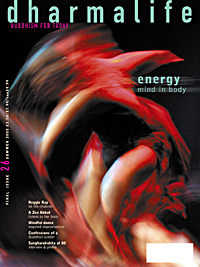The Great Image
The Life Story of Vairochana the Translator
Compiled by Yudra Nyingpo, trans. Ani Jinba Palmo
Shambala Publications 2004, $22.95/£16.99p/b, 332pp
According to the back cover, The Great Image is the autobiography of the Tibetan teacher and translator Vairochana. Inside it reads more like a collection of sketches of the master by his devotees. As is so often the case with such compilations, the biographical part of The Great Image is an unsophisticated mèlange of fact and legend. Born in the 8th century, Vairotsana (as he is called to distinguish him from the archetypal Buddha Vairocana) was one of the greatest translators in Buddhist history. The story plots his hazardous journey to India - where he received many teachings, mainly from Dzogchen masters - his return to Tibet, and subsequent exile. Legend has it that he was an incredible polyglot, mastering 360 languages.
After several chapters devoted to the lineage of Ati Yoga teachings, the story proper begins with the 16 trials Vairochana endured to procure the texts he translated. Most of them are hardly more than listed. His problems with toll-gatherers and robbers along the way, the attempted poisoning by a woman who shelters him, and so on, all fall rather flat. The most memorable ordeal, though briefly told, is the first: the 15-year-old boy leaving behind parents, country, home and friends to embark on his long journey evokes both the pain of separation and the exhilaration of entering the unknown.
It is only much later, when Vairochana, already an old man, returns to Tibet, that the tale began to grab me. Jealous scholars and ministers persuade the king to exile him. Having arrived in Tsawarong, under suspicion as a spy, Vairochana is flung into a frog pit. He emerges with 'frogs clinging to him up to his eyes', but is unscathed. Though this is naively explained as karmic retribution for his former life as a mongoose, it offers a graphic image of the will to endure, whatever the obstacles. From the frog pit he is thrown into a louse pit, but the master survives that as well.
Much of the book is devoted to the celebration of Dzogchen and the history of its lineage. Dzogchen, often identified with Ati Yoga, the highest of the Nine Vehicles according to the Nyingma tradition of Tibetan Buddhism, is proclaimed by Vairochana as 'the essence of all doctrines, summit of all vehicles, king of all tantras'. The vehicle of transmission is bizarre. The Indian master Shri Singha, sitting inside a sealed pot, whispers the pith instructions through a pipe that runs out of a hole in the side of the pot and across the wall behind which the eager Tibetans are crouching.
On his return to Tibet Vairochana teaches the Dharma in verses at times reminiscent of the songs of Milarepa. The text throughout is laced with the terminology of the profound metaphysics of Ati Yoga. Yet the mythical is constantly breaking through. In the chapter on the appearance of the Ati doctrine in the human realm, there is an intriguing echo of Zeus's seduction of Leda in Greek mythology. Vajrapani, Lord of Secrets, descends to Uddiyana in the form of a golden swan, and clings to the breast of the princess, who is bathing on the shores of the lake. 'Touching her breast three times with its beak, a brilliant syllable hum dissolved into her heart.' When her time is come, there springs from the girl's heart a nine-pronged, jewelled vajra, which disintegrates, revealing the child Prahevajra, the first in the human lineage of Dzogchen teachers.
Abhaya is writing a memoir of his time in a Catholic seminary



